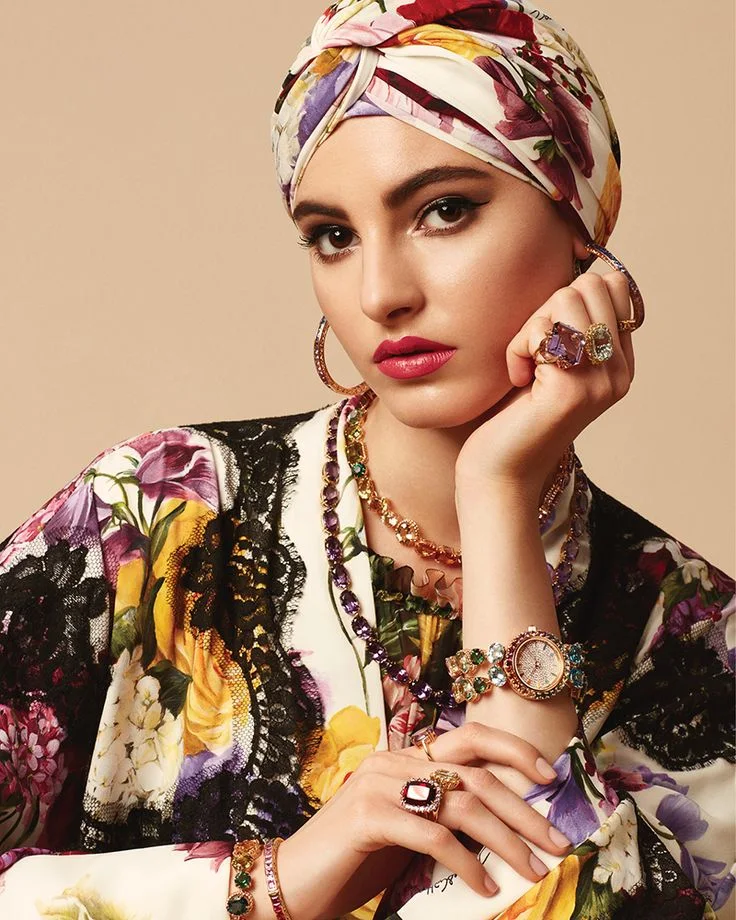The headscarf is much more than just a piece of fabric. It has a rich history and deep cultural significance in many nations around the world, becoming a symbol of status, piety, protection, and beauty.
How Did This Trend Emerge?
The history of wearing headscarves dates back to ancient times, more than 2,000 years ago.
Ancient Egypt and Assyria: The first mentions of the headscarf as a head covering relate to the era of the pharaohs. Here, the headscarf indicated the owner's position in society. Pharaohs wore scarves around their necks for protection from the wind, and their headdress, called the "nemes," was a sign of power.
Ancient Rome: In ancient times, the headscarf was widely used, primarily by men. Roman legionaries tied it around their necks to prevent chafing from armor. In the late antiquity, the headscarf, "sudarium," served to cover the head and wipe away sweat.
Biblical Times: Since biblical times, a woman's covered head was a symbol of nobility, chastity, and humility before her husband. Refusal to wear a headscarf was considered an expression of pride.
Medieval Europe: The headscarf was used as a symbol of romantic love; ladies would attach it to a knight's spear.
Rus': The headscarf became an integral part of Russian costume, especially for women. With the advent of Orthodoxy, women began to cover their heads, which became a symbol of morality, purity, and modesty. In various regions, headscarves had their own unique features, for example, Pavlov Posad shawls with their large floral patterns.
The East: In the Arab East, handkerchiefs were a privilege of the nobility. In Azerbaijan, kalagayi (traditional headscarves) became a fabulous chronicle of the people, distinguished by their richness and intricate patterns.
Overall, the spread of the headscarf depended on weather conditions, religious traditions, and local customs in a given geographical location.
How Were Headscarves Painted?
Painting headscarves is an ancient art that developed differently across various cultures.
Printed Headscarves: The first printed headscarves with designs appeared in Northern Europe in the 18th century.
Batik: The inhabitants of the Indonesian island of Java perfected an ancient artistic painting technique, calling it "batik." The ideal fabric for batik was and remains silk, which perfectly absorbs dye and gives it luster. This technique allows for the creation of incredible color transitions and intricate patterns.
Traditional Russian Painting (e.g., Pavlov Posad shawls): Characterized by large flowers, plant motifs, and a contrasting background. The coloring and composition of the drawing often had symbolic meaning, reflecting the fusion of man with nature.
Kalagayi (Azerbaijan): These often multi-colored headscarves were created by boiling, dyeing, and drying the fabric several times, which allowed for deep and rich colors.
Embroidery: In addition to painting, headscarves were often decorated with embroidery, especially in ancient times. Maiden's wreaths (uvyasla) in Rus', for example, were embroidered as richly as possible, sometimes with gold.
Modern designers use various technologies for applying patterns to fabric, creating exclusive products with unique combinations of designs.
How to Wear Headscarves?
There are a multitude of ways to wear a headscarf, and they vary depending on cultural traditions, fashion trends, and personal preferences. Here are a few popular options:
On the head:
Classic retro knot under the chin: The scarf is folded diagonally, covers the head, and the pointed ends are tied under the chin.
At the nape ("Parisienne," bandana): The scarf is draped over the head, and the ends are tied at the nape. This can be a simple bandana or a more complex knot.
Turban or chador (chalma): The scarf is wrapped around the head, the ends are crossed on the forehead or at the nape, and then secured, creating a voluminous structure.
Hair accessory: The scarf can be braided into a plait, wrapped around a bun or ponytail, or used as a headband.
Scarf hood: The scarf is worn over the head like a hood, the ends are crossed at the neck and thrown back or secured with a brooch.
On the neck:
Classic side or front knot: The scarf is tied with a simple knot, adding elegance to the look.
Cowboy/scout style: The scarf is tied around the neck, with the loose ends hanging in front or thrown over the shoulder.
Twilly: A narrow strip-like scarf that can be tied into a bow or a necktie.
Other ways:
On the shoulders: Simply drape the scarf over the shoulders so the corners hang in front.
Scarf top: The scarf is folded diagonally and tied at the chest or back, creating a light summer top.
As a belt: The scarf can be threaded through the belt loops of jeans, tied over a dress or coat, accentuating the waist.
Bag accessory: The scarf can be tied to a bag handle, adding a bright accent to the outfit.
On the wrist or ankle: For more unconventional solutions.
The choice of how to wear a headscarf depends on the scarf's size, material, mood, and the overall style of the outfit. Modern trends encourage experimenting with scarves, allowing for the creation of unique and stylish combinations.















Comments
Post a Comment